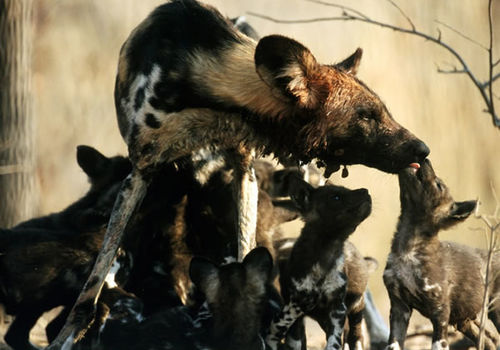
Wild dog
Lycaon pictusWild dog
Introduction: The African wild dog (Lycaon pictus) is one of Africa's most endangered mammal species. Various factors contribute to its decline in numbers:
Persecution by mankind, including until recently within conservation areas.
Infection from diseases such as rabies and distemper when in contact with domestic animals.
Its specific Latin name 'pictus' means painted and refers to its patched coat. The wild dog is unmistakable among medium-sized carnivores; characteristic features include large rounded ears, long legs, bushy and broad white-tipped tails.
The African wild dog are specifically adapted to living in packs, one of the primary functions being to secure food. An advantage of pack hunting is an increased probability of success and higher efficiency of food resources. They are gregarious (fond of company) and packs of between 12 - 20 dogs are normal, although groups sizes can be as large as 40.
The packs normally hunt in the early morning and late afternoon and use sight rather than smell to detect their prey. It is to their advantage to use open plains and they avoid forest or woodland with thick underbush. Hyenas are no match for wild dogs when it comes to serious food competition and often get a severe mauling. Killing is a team effort, chasing their prey to exhaustion before tearing it apart together.
Distribution: Today the African wild dog can only be found in the north and eastern regions of Namibia such as in Kaodom Game Park, Kavango and Caprivi.
Diet: Small antelope such as duiker are susceptible to wild dog attacks, but they prefer something more substantial such as buffalo, cattle and zebra.
Colouring: A blotched coat of black, yellow and white markings, of which no two are exactly alike in pattern.
Breeding: It is to this predator's advantage to have their young in the dry season, when the countryside is open and visibility is at its best. The gestation period is 70 days and only the dominant (alpha) pair breed in a pack. The average litter is between 7 and 10.
Size: Measuring 750mm at the shoulders, males are slightly larger than females and weigh 20-30kg, heavier than their East African cousins, whose diet mainly consist of the smaller Thompson's gazelle.
Klein Windhoek

